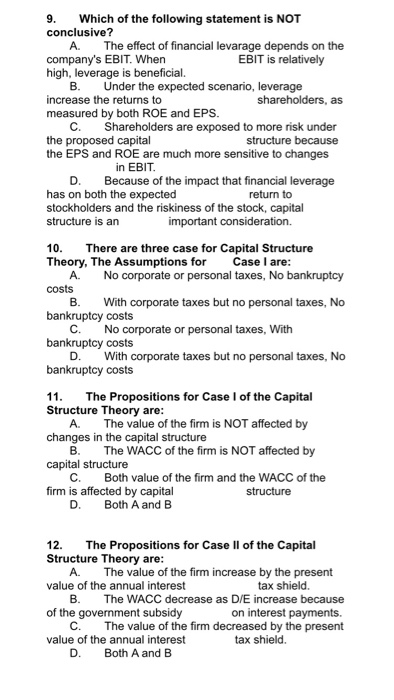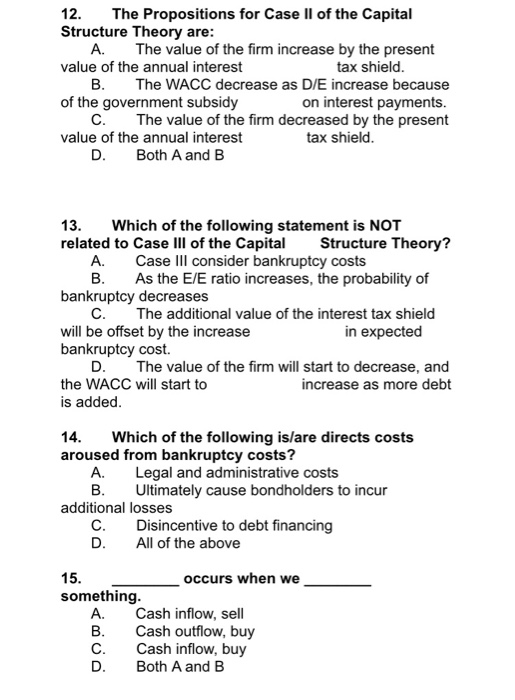9. Which of the following statement is NOT conclusive? A. The effect of financial levarage depends on the company's EBIT. When EBIT is relatively high, leverage is beneficial. B. Under the expected scenario, leverage increase the returns to shareholders, as measured by both ROE and EPS. C. Shareholders are exposed to more risk under the proposed capital structure because the EPS and ROE are much more sensitive to changes in EBIT. D. Because of the impact that financial leverage has on both the expected return to stockholders and the riskiness of the stock, capital structure is an important consideration. 10. There are three case for Capital Structure Theory, The Assumptions for Case I are: A. No corporate or personal taxes, No bankruptcy costs B. With corporate taxes but no personal taxes, No bankruptcy costs C. No corporate or personal taxes, With bankruptcy costs D. With corporate taxes but no personal taxes. No bankruptcy costs 11. The Propositions for Case of the Capital Structure Theory are: A. The value of the firm is NOT affected by changes in the capital structure B. The WACC of the firm is NOT affected by capital structure C. Both value of the firm and the WACC of the firm is affected by capital structure D. Both A and B 12. The Propositions for Case Il of the Capital Structure Theory are: A. The value of the firm increase by the present value of the annual interest tax shield. B. The WACC decrease as D/E increase because of the government subsidy on interest payments. C. The value of the firm decreased by the present value of the annual interest tax shield. D. Both A and B 12. The Propositions for Case II of the Capital Structure Theory are: A. The value of the firm increase by the present value of the annual interest tax shield. B. The WACC decrease as D/E increase because of the government subsidy on interest payments. C. The value of the firm decreased by the present value of the annual interest tax shield. D. Both A and B 13. Which of the following statement is NOT related to Case Ill of the Capital Structure Theory? A. Case Ill consider bankruptcy costs B. As the E/E ratio increases, the probability of bankruptcy decreases C. The additional value of the interest tax shield will be offset by the increase in expected bankruptcy cost. D. The value of the firm will start to decrease, and the WACC will start to increase as more debt is added. 14. Which of the following is/are directs costs aroused from bankruptcy costs? A. Legal and administrative costs B. Ultimately cause bondholders to incur additional losses c. Disincentive to debt financing D. All of the above 15. occurs when we something. Cash inflow, sell Cash outflow, buy Cash inflow, buy Both A and B os 9. Which of the following statement is NOT conclusive? A. The effect of financial levarage depends on the company's EBIT. When EBIT is relatively high, leverage is beneficial. B. Under the expected scenario, leverage increase the returns to shareholders, as measured by both ROE and EPS. C. Shareholders are exposed to more risk under the proposed capital structure because the EPS and ROE are much more sensitive to changes in EBIT. D. Because of the impact that financial leverage has on both the expected return to stockholders and the riskiness of the stock, capital structure is an important consideration. 10. There are three case for Capital Structure Theory, The Assumptions for Case I are: A. No corporate or personal taxes, No bankruptcy costs B. With corporate taxes but no personal taxes, No bankruptcy costs C. No corporate or personal taxes, With bankruptcy costs D. With corporate taxes but no personal taxes. No bankruptcy costs 11. The Propositions for Case of the Capital Structure Theory are: A. The value of the firm is NOT affected by changes in the capital structure B. The WACC of the firm is NOT affected by capital structure C. Both value of the firm and the WACC of the firm is affected by capital structure D. Both A and B 12. The Propositions for Case Il of the Capital Structure Theory are: A. The value of the firm increase by the present value of the annual interest tax shield. B. The WACC decrease as D/E increase because of the government subsidy on interest payments. C. The value of the firm decreased by the present value of the annual interest tax shield. D. Both A and B 12. The Propositions for Case II of the Capital Structure Theory are: A. The value of the firm increase by the present value of the annual interest tax shield. B. The WACC decrease as D/E increase because of the government subsidy on interest payments. C. The value of the firm decreased by the present value of the annual interest tax shield. D. Both A and B 13. Which of the following statement is NOT related to Case Ill of the Capital Structure Theory? A. Case Ill consider bankruptcy costs B. As the E/E ratio increases, the probability of bankruptcy decreases C. The additional value of the interest tax shield will be offset by the increase in expected bankruptcy cost. D. The value of the firm will start to decrease, and the WACC will start to increase as more debt is added. 14. Which of the following is/are directs costs aroused from bankruptcy costs? A. Legal and administrative costs B. Ultimately cause bondholders to incur additional losses c. Disincentive to debt financing D. All of the above 15. occurs when we something. Cash inflow, sell Cash outflow, buy Cash inflow, buy Both A and B os








